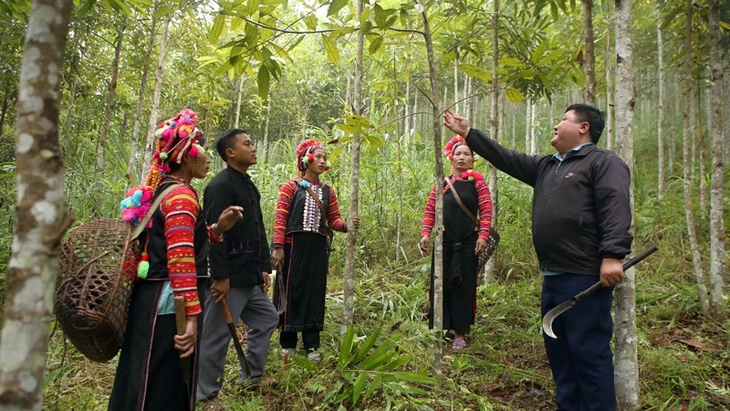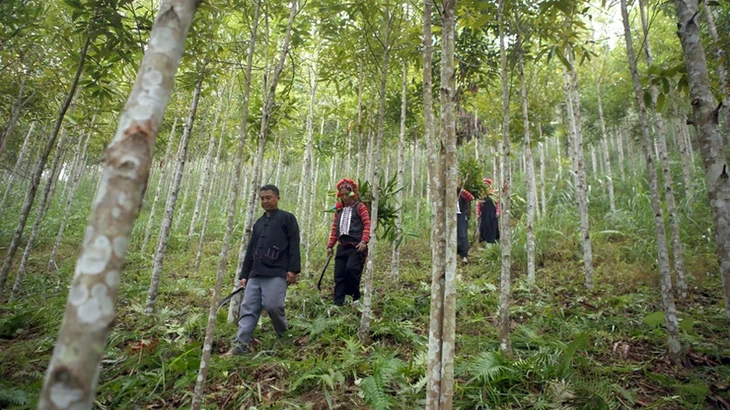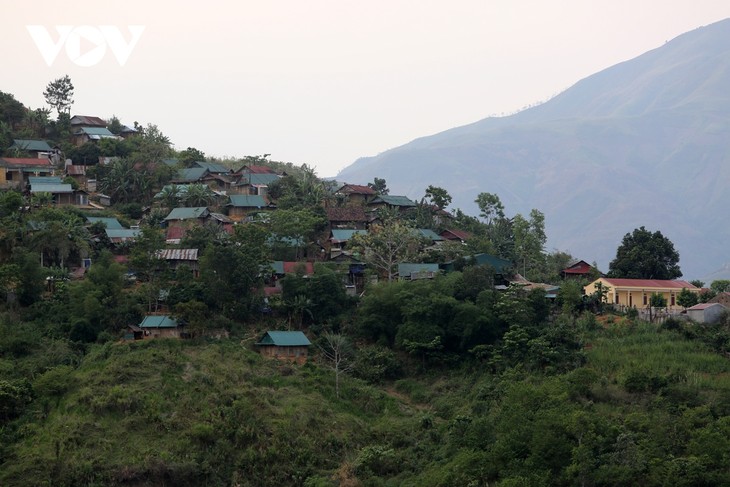(VOVWORLD) -The bare hillsides and impoverished terrace fields in Lai Chau province are being covered with cinnamon trees. The area of cinnamon cultivation is expanding, bringing income to local farmers and promising imminent prosperity.
 Agricultural officers of Muong Te district teach local farmers how to prune branches and leaves to ensure tree growth. (Photo: VOV) Agricultural officers of Muong Te district teach local farmers how to prune branches and leaves to ensure tree growth. (Photo: VOV) |
Pac Ma hamlet in Muong Te district, home to 100 Thai and La Hu ethnic families, is green with cinnamon trees at this time of year. Cinnamon trees have been growing here for nearly a decade, gradually covering terrace fields where grass used to grow.
Vang Lo Pu of the La Hu ethnic group in Pac Ma hamlet says she and some other villagers began to grow cinnamon in 2016 under the instructions of the commune and district administrations.
Hardy and compatible with the local soil, the cinnamon trees have grown very well. 4 years after planting, the initial pilot area was harvested. Their 1.6 hectares of cinnamon earns Pu’s family 1,200 USD a year.
Pu told VOV, “My family began to grow cinnamon trees in 2017. After 3 years, our cinnamon could be harvested. Thanks to cinnamon, our living conditions have gotten much better. We’re no longer worried about money.”
 Cinnamon has become a key crop in the border district of Muong Te. (Photo: VOV) Cinnamon has become a key crop in the border district of Muong Te. (Photo: VOV) |
With seedlings and fertilizers provided by the local government, people in Muong Te commune have expanded their cultivation area. Most of the previously infertile agricultural land has been converted to cinnamon trees. The commune now has 200 hectares of cinnamon and is continuing to expand that total, intending to make cinnamon a key crop of the locality.
Ly Van Chanh, Deputy Chairman of the People's Committee of Muong Te commune, said cinnamon trees were first planted in Muong Te commune in 2016 on just 10 hectares. “In the following years, we encouraged villagers to get involved and now have an area of more than 200 hectares. Cinnamon trees are suited to the local climate and are producing very good economic results,” said Chanh.
In 7 years, cinnamon trees have been planted on 2,300 hectares in 13 communes and towns in the border district of Muong Te. More than half of the 4-year-old trees were pruned for sale, earning 600 to 800 USD and reducing the local poverty rate by more than 5% a year.
According to Dao Van Khanh, Chairman of the People's Committee of Muong Te district, “After years of studying agricultural and forestry models, the district chose the right direction – growing cinnamon. With the income from cinnamon, the locals can now build spacious houses and count on a stable income.”
 Thanks to cinnamon trees, ethnic minority hamlets in Muong Te district have changed dramatically. (Photo: VOV) |
Muong Te district has attracted investors and buyers for the cinnamon farmers. The first cinnamon processing plant in Lai Chau has been built and put into operation in Muong Te district. With a raw material capacity of 100 tons of branches and leaves a day, the factory is giving thousands of local households a stable income.
Khanh added that Muong Te has made cinnamon a key part of local development and poverty reduction and intends to plant 3,800 to 4,000 hectares of cinnamon by 2025 and 10,000 hectares by 2030.
“We are selecting investors to help the locals develop cinnamon throughout the district. 3 investors have been approved by the provincial administration to survey and grow cinnamon trees,” said Khanh, adding that investors have coordinated with people in communes with suitable potential, climate, and soil to expand the cinnamon-growing area.
The cinnamon area in Muong Te district is expanding and cinnamon is becoming a key part of local poverty reduction.